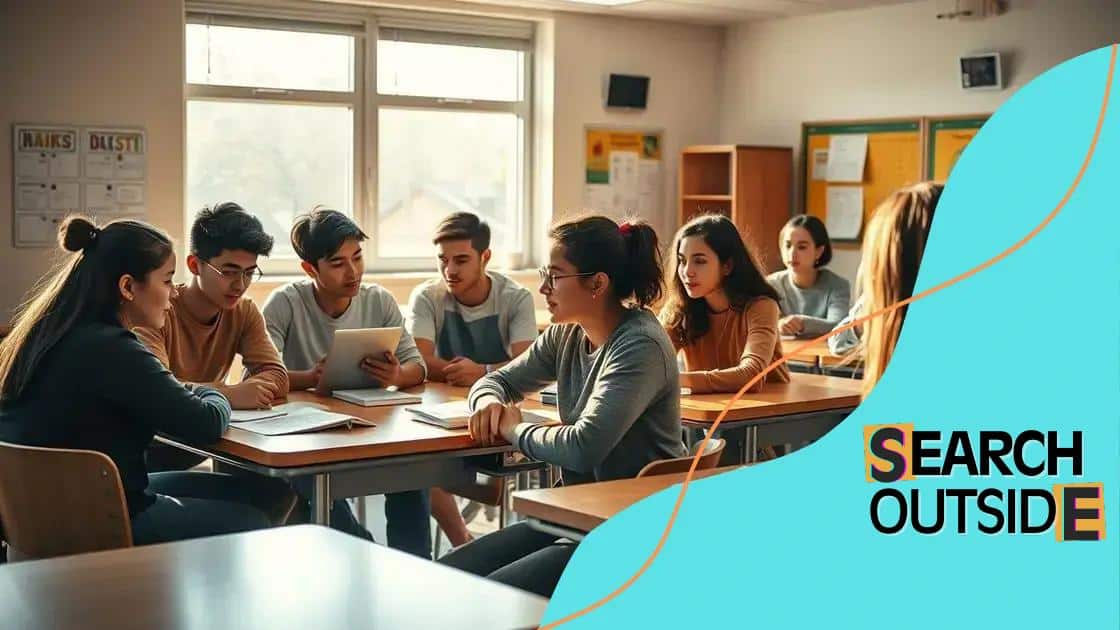The rise of remote learning and its future in K-12 schools

The rise of remote learning and its future in K-12 schools emphasizes hybrid models that combine in-person and online education to enhance flexibility, engagement, and preparedness for a technology-driven workforce.
The rise of remote learning and its future in K-12 schools is transforming how students engage with education. Have you considered how this shift affects not just students but entire communities? Let’s dive into the implications.
Understanding remote learning benefits
Understanding the benefits of remote learning is crucial as it changes how education is delivered. This mode of learning offers flexibility that traditional classrooms cannot match. Students can access resources anytime, anywhere, which fosters a more self-directed learning approach.
Flexibility and Accessibility
Remote learning allows students to learn at their own pace. This flexibility means they can revisit complex topics as needed. Furthermore, students with different learning styles can benefit from various online resources. For instance, visual learners may prefer video content, while others might favor interactive quizzes.
- Flexible scheduling for lessons
- Access to diverse learning resources
- Ability to learn from anywhere
- Support for different learning styles
Another important benefit is the development of critical tech skills. Students learn to navigate various online tools, which is essential in today’s workforce. They also develop time management skills as they balance their studies with home learning.
Enhanced Engagement
Online platforms often use interactive elements to engage students. Features such as live polls and breakout rooms can make lessons more interactive. This can lead to higher motivation and participation in the learning process.
- Interactive lessons increase student interest
- Real-time feedback enhances learning
- Collaboration tools foster teamwork
In addition, remote learning can also promote a sense of ownership over one’s education. Students take charge of their learning and are more involved in setting goals and choosing their paths. This increased autonomy boosts their confidence and prepares them for future challenges.
Key technologies driving remote education
Key technologies driving remote education play a major role in how learning is delivered today. These tools make it easier for both students and teachers to connect, wherever they are. From learning management systems to collaboration tools, technology is shaping the classroom experience.
Learning Management Systems (LMS)
LMS platforms are crucial for organizing course materials and tracking student progress. They allow teachers to create assignments, grade submissions, and communicate with students all in one place. Examples like Moodle and Canvas help streamline these processes, making education more efficient.
- Centralizes resources and materials
- Facilitates communication between students and teachers
- Tracks student progress and performance
- Enables easy access to course content
Another technology impacting remote education is video conferencing tools. Programs like Zoom, Google Meet, and Microsoft Teams have transformed how classes are conducted. These platforms allow for real-time interaction and collaboration, providing a classroom-like environment online.
Interactive Learning Tools
Interactive tools enhance engagement in remote learning. Platforms like Kahoot! and Nearpod enable teachers to create quizzes and interactive lessons that keep students interested. This active participation helps improve retention rates and motivates students to learn more.
Moreover, virtual reality (VR) and augmented reality (AR) are emerging technologies that promise to revolutionize remote education. With VR, students can explore virtual worlds, while AR can help them visualize complex subjects in 3D. These immersive experiences can deepen understanding and make learning more enjoyable.
Cloud Storage Solutions
Lastly, cloud storage solutions such as Google Drive and Dropbox allow easy access to materials anytime, anywhere. These platforms ensure that students can store and share their work, collaborate on group projects, and retrieve files without hassle.
Engagement strategies for remote classrooms

Engagement strategies for remote classrooms are essential to keep students focused and motivated. In a virtual setting, it can be challenging to capture students’ attention. However, with the right approaches, teachers can create an interactive and dynamic learning environment.
Using Interactive Tools
Incorporating interactive tools, like polls and quizzes, can enhance student participation. Platforms such as Kahoot! allow for fun quiz competitions that keep students engaged. Live polls during lessons help gauge understanding and encourage lively discussions.
- Quizzes promote active learning
- Polling encourages instant feedback
- Group activities foster collaboration
- Gamification increases motivation
Another effective strategy involves using breakout rooms in video conferencing tools. This allows students to work in smaller groups on projects or discussions, promoting interaction and teamwork. These sessions enable students to express their thoughts and learn from one another.
Personalizing the Learning Experience
Personalizing lessons can also boost engagement. Allowing students to choose projects that interest them can give them a sense of ownership over their learning. This can lead to increased motivation and better outcomes.
Regular check-ins with students provide opportunities for educators to offer support and feedback. These interactions help build relationships and keep students connected to the classroom, even when learning remotely.
Creating a Positive Online Environment
Finally, establishing a positive online environment is crucial. Teachers should create a space where students feel safe to express their ideas and questions. Encouraging a culture of respect and inclusivity can make remote classrooms feel more like a community.
Using positive reinforcement and celebrating student achievements can further motivate learners. Acknowledging hard work fosters a sense of accomplishment and encourages them to stay engaged.
Challenges and solutions in K-12 remote learning
Challenges and solutions in K-12 remote learning are vital discussions as schools adapt to new educational landscapes. Many students face hurdles when learning online, but understanding these challenges can lead to effective solutions.
Technical Issues
One major challenge is the access to technology. Not all students have reliable internet or devices at home. This digital divide can prevent equal access to learning opportunities. Schools are working to provide laptops and hotspots to families in need.
- Providing technology resources to students
- Implementing community Wi-Fi programs
- Offering tech support for families
Another common issue is the lack of familiarity with digital platforms. Some students struggle to navigate online tools, leading to frustration. To combat this, schools can offer technology training sessions to help students and parents feel more comfortable.
Maintaining Engagement
Engagement can also be a significant challenge in remote learning. Without the physical presence of teachers and peers, students may feel isolated or distracted. To tackle this, teachers should use varied teaching methods to keep learning exciting. Interactive lessons and virtual group work can foster a sense of community.
Furthermore, regular communication between teachers and students is essential. Scheduling one-on-one check-ins can ensure that students feel supported and motivated throughout the learning process.
Balancing Workload
Another challenge is managing the workload for students and teachers alike. Remote learning can sometimes lead to feelings of being overwhelmed due to the volume of assignments and online classes. Teachers should communicate expectations clearly and provide flexibility where possible.
Encouraging students to manage their time effectively is beneficial as well. Teaching time management skills can help students balance their schoolwork with other responsibilities at home.
The future of education: hybrid models in schools
The future of education is increasingly leaning towards hybrid models in schools. These models combine in-person and online learning, allowing for more flexible educational experiences. As schools adapt to new demands, hybrid learning can meet the needs of diverse student populations.
Flexibility in Learning
One of the main advantages of hybrid models is flexibility. Students can attend classes in person when required, while also having the opportunity to complete assignments and access materials online. This balance helps accommodate different learning styles and paces, making education more personalized.
- Students can learn at their own pace
- Access to a wider range of resources
- Opportunity for personalized learning experiences
- Can easily adapt to changes in circumstances
Additionally, hybrid models prepare students for the future workforce, which increasingly relies on technology and remote collaboration. As students learn to navigate a blend of in-person and digital environments, they build essential skills that will serve them well in their careers.
Boosting Engagement
Another benefit of hybrid education is its potential to boost engagement. By integrating technology into the learning process, teachers can create dynamic and interactive lessons. For instance, using online forums or discussion boards can encourage collaboration among students.
Further, hybrid classes often leverage multimedia resources, which can make lessons more interesting. This approach not only keeps students engaged but also helps enhance their understanding of complex topics.
Challenges and Considerations
However, implementing hybrid models is not without challenges. Institutions must ensure that all students have equal access to necessary technologies. Providing robust tech support is essential to help students and teachers adapt to new tools effectively.
Moreover, training teachers for this dual approach is crucial. Professional development programs should focus on blending traditional teaching methods with innovative technology-enhanced strategies, ensuring that educators are well-equipped to facilitate learning in hybrid environments.
Conclusion
The future of education lies in embracing hybrid models that blend in-person and online learning. These models offer flexibility, boost student engagement, and prepare learners for a technology-driven world. While challenges exist, schools can overcome them by providing access to technology and supporting educators. Ultimately, the shift to hybrid learning models can create a more inclusive and effective educational environment for all students.
FAQ – Frequently Asked Questions about Hybrid Models in Education
What are hybrid models in education?
Hybrid models combine in-person and online learning to create a flexible educational experience for students.
How do hybrid models enhance student engagement?
They incorporate interactive tools like quizzes and discussions, making lessons more lively and ensuring students stay involved.
What challenges do schools face when implementing hybrid learning?
Challenges include ensuring all students have access to technology, providing adequate training for teachers, and maintaining student engagement.
How can hybrid models better prepare students for the future?
By blending traditional learning with technology, students develop essential skills for a tech-driven workforce, such as collaboration and digital literacy.





